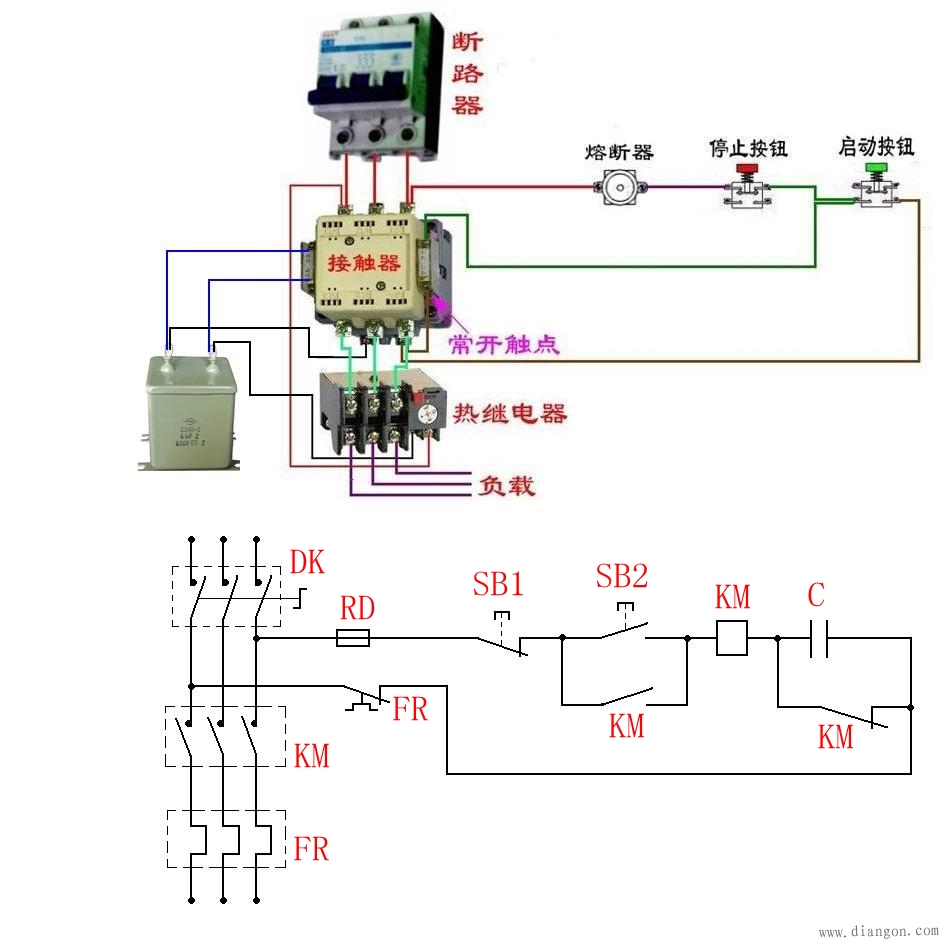
To enable a motor to rotate in both forward and reverse directions, two contactors, KM1 and KM2, can be used to reverse the phase sequence of the three-phase power supply connected to the motor. However, it is crucial that these two contactors do not operate simultaneously, as this could cause a short circuit. To prevent such an accident, a reliable interlocking mechanism must be implemented in the circuit. The diagram illustrates a control circuit that uses both button and contactor interlocking for safe forward and reverse operation of the motor. Here’s a breakdown of how the system works: 1. **Forward Start:** - First, close the air switch QS to supply power to the system. - Press the forward start button SB3. This energizes KM1, which then latches itself via its auxiliary contacts. The main contacts of KM1 close, allowing the motor to run in the forward direction with a phase sequence of L1, L2, L3. 2. **Reverse Start:** - Again, close the air switch QS. - Press the reverse start button SB2. This energizes KM2, which latches through its own auxiliary contacts. The main contacts of KM2 close, reversing the phase sequence to L3, L2, L1, causing the motor to rotate in the reverse direction. 3. **Interlocking Mechanism:** - **Contactor Interlock:** The coil circuit of KM1 includes a normally closed contact from KM2, and vice versa. When KM1 is energized, its normally closed contact opens, preventing KM2 from being activated until KM1 is de-energized. This ensures that both contactors cannot be active at the same time, avoiding a dangerous short circuit. - **Button Interlock:** The buttons SB2 and SB3 each have a pair of normally open and normally closed contacts. These are wired to the coils of KM1 and KM2 respectively. For example, pressing SB2 closes the normally open contact for KM2 and opens the normally closed contact for KM1. This prevents both contactors from being energized at once, providing an additional layer of safety. 4. **Direction Change Without Stop:** Once the motor is running in one direction, you don’t need to press the stop button first. Simply pressing the opposite direction button will change the rotation without needing to stop the motor first. 5. **Overload Protection:** The thermal relay FR provides overload protection for the motor. If the motor draws too much current, the thermal relay will trip, cutting off power to protect the motor from damage. **Motor Reversible Control Circuit Wiring and Testing:** - Before powering up, ensure that the main circuit wiring is correct. It's important to maintain consistent phase connections between the contactors so that the phase sequence can be reliably reversed when needed. - After verifying the wiring, perform a power-on test. To avoid accidents, disconnect the motor wiring before testing the circuit. **Common Faults and Solutions:** - **Motor Does Not Start:** Check if the control fuse FU is blown, if the thermal relay FR has incorrect or poor contact, or if the normally closed contact of SB1 is faulty. Also, verify that the button interlock is properly set up. - **Contactor Fails to Engage:** This may happen due to incorrect interlocking of normally closed contacts, or if the contactor is locked in place by its own contacts. A faulty coil or improper wiring can also cause this issue. - **No Self-Locking:** If the contactor doesn’t stay engaged after being pressed, check the self-locking contacts. Incorrect wiring here can prevent the contactor from remaining active. **Connection Method Overview:** - **Method 1:** A standard three-phase contactor typically has 8 terminals—three inputs, three outputs, and two control points. The output and input terminals are usually aligned and easy to identify. To add a lock, connect a wire from the output terminal to the control point. - **Method 2:** Understanding the basic principle of an AC contactor is essential. It uses an external power source applied to the coil to generate an electromagnetic field. When the coil is energized, the contacts close; when the power is removed, they open. Identify the coil terminals (usually located at the bottom of the contactor), and note the voltage rating (typically 220V or 380V). Pay attention to whether the contacts are normally open or closed. With this knowledge, you can implement self-locking control based on the circuit design.

Anti-noise Microphone Supplies
Anti-noise Microphone,Anti-noise Mini Microphone,dynamic Anti-noise Microphone ,Anti-noise Microphone for headsets
Gaoyou Huasheng Electronics Co., Ltd. , https://www.yzelechs.com